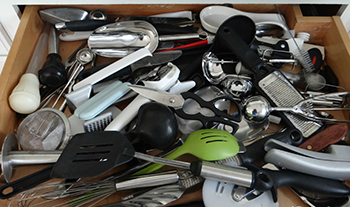How Cleaning Out Your Kitchen Drawers Can Help You Rationalize Your Marketing Infrastructure
- Every new technology and feature is intended to provide some form of capability – and they should be evaluated on that basis
- Are the capabilities a shiny new technology provides something you really need?
- Apply the “kitchen gadget” test to your marketing infrastructure to help you make effective decisions about what you truly need
If you’re anything like me, then over the years you’ve amassed an entire kitchen’s worth of tools and gadgets – everything from hulking stainless steel behemoths that purport to make coffee and split the atom to small indecipherable devices designed to do rare, highly specialized tasks, like dicing cherries.
 When I’m asked why I have all these kitchen items, my default answer is “because I need them” – and when I bought them I truly did believe that they were necessary. Last month, though, after getting an ultimatum about the overflowing state of every cabinet and drawer in the kitchen, I piled all my gadgets on the table and reevaluated the necessity of each one.
When I’m asked why I have all these kitchen items, my default answer is “because I need them” – and when I bought them I truly did believe that they were necessary. Last month, though, after getting an ultimatum about the overflowing state of every cabinet and drawer in the kitchen, I piled all my gadgets on the table and reevaluated the necessity of each one.
What I learned through that exercise is that while every one of my gadgets and tools did something useful, often the capability they provided was unnecessary or duplicative. The cherry dicer, for example, comes in handy when you have to dice hundreds of cherries quickly, but if you’re handling normal quantities, a simple paring knife would also do the job. Also, while that handmade, custom-curved shellfish fork might serve as a good conversation piece and be marginally more effective than your standard silverware, a simple fork can also do that job. After applying that thinking, I ended up with a pile of items to donate and drawers that can now close.
Looking back on that task, I realized later that this approach to evaluation could also address one of the most complex and daunting tasks faced by marketing professionals today: sorting through the ever-growing list of marketing technologies available. When you cut through the hype, every new technology and feature is intended to provide some form of capability – and they should be evaluated on that basis. Are the capabilities a shiny new technology provides something you really need? Do those capabilities already exist somewhere in your current infrastructure? Can your company actually utilize those capabilities effectively?
In our session at the upcoming SiriusDecisions Technology Exchange, my colleague Bruce Brien and I will outline a structured approach to applying the “kitchen gadget” test to your marketing infrastructure to help you make effective decisions about what you truly need. Join us to learn how to ask the right questions and avoid having the marketing technology equivalent of the dusty, unused pasta-maker sitting on your marketing countertop.
We hope you’ll make plans to join us at the SiriusDecisions Technology Exchange so we can further inspire you to sort your gadgets as well.